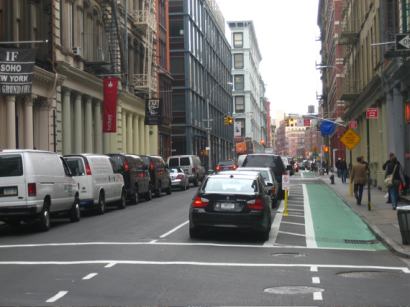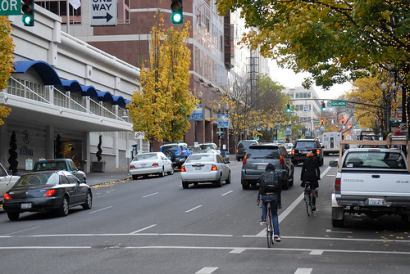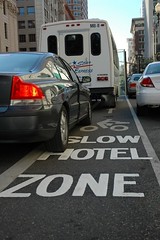“Sam (Adams) has directed (City Traffic Engineer) Rob Burchfield to indentify opportunities for a “high visibility” cycle track to be rolled out in Sam’s first 100 days as mayor.”
— Sam Adams’ chief of staff Tom Miller, in an email to Metro Councilor Rex Burkholder
There’s no denying that 2009 is shaping up to be the Year of the Cycle Track in Portland.
PDOT already has one in the books for NE Cully Blvd., they’re working closely with streetcar planners to put one adjacent to the new line in the Lloyd District on NE 7th Ave., and planners, advocates, and other local bike insiders (including our next Mayor and his chief of staff) are all singing the cycle track’s praises after seeing them in action in cities like Amsterdam and Copenhagen.
But you can’t simply copy-paste the idea from those world-class bike cities where 30-40% of all trips are made by bike and where official policies aggressively prioritize bike traffic over motor vehicle traffic.
That’s why true, European-style cycle tracks — built on a separate grade from car and pedestrian traffic — are challenging to build in Portland. PDOT engineers were able to pull a Copenhagen-esque facility off on NE Cully because they had a clean slate to work with (it’s a complete road rebuild) and the land-use in that area is residential.
The challenge will be how to build a cycle track in an urban context like in downtown Portland. With short block-faces and numerous driveways, PDOT has to move much more cautiously. That being said, there is more likelihood that Portland’s future downtown cycle-tracks will be a watered down, “American-style” version.
One location where we might see the first attempt a physically separated bikeway/cycle track treatment in downtown Portland could be SW Broadway. That street is a major artery in the bikeway network as it serves traffic coming off the Broadway Bridge and it runs into the heart of downtown.
Broadway is also a familiar nemesis to both riders and PDOT engineers. Many who bike on Broadway feel the existing standard bike lane is more dangerous to ride in than simply taking the lane. However, most riders — especially less experienced ones — still use the bike lane despite its drawbacks.
From PDOT’s perspective, they know SW Broadway is a hot-spot for crash activity and that it’s one of the most unpopular (yet busy) bikeways in the city. They’ve made a stop-gap attempt to make it better by writing “Hotel Zone Warning” in the bike lane in order to warn riders that valets, cabbies, and tourists might not respect their travel lane.
Rex Burkholder, founder of the BTA, now a Metro Councilor, and Chair of Metro’s powerful Joint Policy Advisory Committee on Transportation (JPACT) is one of the many local transportation heavy-hitters (including PDOT’s head traffic engineer) who recently experienced cycle tracks first-hand in Europe.
“Time for bold action, not retrenchment.”
— from a letter by Rex Burkholder to Mayor-elect Sam Adams
Fresh off a trip to Amsterdam and Copenhagen as part of a fact-finding mission for Metro’s Blue Ribbon Committee for Trails, Burkholder wrote Portland’s transportation commissioner and Mayor-elect Sam Adams a letter (dated 11/24) on what things Portland might do in the near-term to emulate those model biking cities.
In that letter (which Burkholder has given me permission to excerpt from), Burkholder told Adams that this is a “Time for bold action, not retrenchment” and he wrote specifically about cycle tracks:
The time is ripe for these innovations in Portland: Current bike lanes are just too narrow for the amount of bike traffic on many feeders into downtown so that we get congestion and conflict among cyclists.
I think they have tremendous potential to help more people feel safe riding, are relatively easy and inexpensive to install and can increase the capacity of our main line cycle routes.
One of the locations suggested by Burkholder for the cycle track treatment was SW Broadway.
Adams’ chief of staff Tom Miller replied via email to Burkholder. I obtained a copy of that email and in it, Miller wrote:
We certainly agree that Portland can and should continue innovating (as an American city) to provide safer, more effective facilities for would-be bicyclists. Many, if not all, of your specific ideas are good ones.
Miller than listed several “important strides” PDOT is making to “bring Dutch and Danish accomplishments to Portland.” One of those is to identify opportunities for a “high visibility” cycle track to be “rolled out in Sam’s first 100 days as mayor.” Miller went on to write that, “Like you, I think SW and/or NE Broadway could be ripe for an improved street treatment.”
A few weeks ago, New York City-based livable streets blog Streetsblog shared a story about the success of their own “American-style” separated bike lane on Grand Street in downtown New York City.
That facility (shown below) struck me as being very similar to the road configuration that currently exists on SW Broadway. Compare this view of Grand Street in NYC…

… with this view of SW Broadway in Portland:

It seems like riding conditions on SW Broadway could be vastly improved with a Grand Ave-style treatment and it would not require any major engineering or large budget to make it happen. Also, with momentum from respected advisors and their own, first-hand experience with these types of facilities, it seems PDOT, with Mayor-elect Adams at the helm, is poised to make it happen.
It will be very interesting to observe how PDOT deals with increasing pressure to build innovative bike facilities. The Copenhagen Effect will no doubt be a powerful force in the coming years.



